Ijraset Journal For Research in Applied Science and Engineering Technology
- Home / Ijraset
- On This Page
- Abstract
- Introduction
- Conclusion
- References
- Copyright
Preparation and Phytochemical Analysis of Polyherbal Tea Bag
Authors: Miss. Deveshvari Deepak Chaudhary , Mr. Tanmay Rajendra Chaudhari , Mr. Rutik Gopal Chaudhari , Mr. Sunil Kanaram Chaudhari , Dr. Sunila Patil
DOI Link: https://doi.org/10.22214/ijraset.2024.61356
Certificate: View Certificate
Abstract
Herb blooms, leaves, seeds, roots, or dried fruit that aren\\\'t from the Camellia sinensis tea plant are referred to as herbal tea. Lemongrass, cinnamon, hibiscus, and butterfly pea (Clitoria ternatea) are a few plants that can be used to make herbal teas. The butterfly pea is traditionally used as a culinary coloring to give food its blue color and as an eye medication, brain boosting. As antioxidants, antibacterial, anti-inflammatory, antidiabetic, anti-cancer, and immunomodulatory agents, butterfly pea and hibiscus are beneficial and reduce blood pressure. In order to improve the quality of the herbal tea, it is necessary to dry the tea utilizing sunshine throughout the producing process. Organoleptic tests are used to conduct the analysis (color, taste, and scent).
Introduction
I. INTRODUCTION
Herbal teas, a popular beverage consumed for centuries, differ from traditional teas like green and black tea, as they are crafted from various plant parts besides Camellia sinensis leaves. They are brewed similarly to standard teas and can be categorized by type (e.g., cinnamon, dandelion) or health function (e.g., cognitive health, gut health).[1][2]
Rich in polyphenols, herbal teas offer diverse health benefits. For example, cinnamon tea contains procyanidins and catechins, while dandelion tea boasts flavonoids and phenolic acids. Chamomile tea is abundant in flavonoids such as apigenin and quercetin, and peppermint tea is also packed with flavonoids.[3][4]
These polyphenols contribute to herbal teas' antioxidant, anti-inflammatory, and other health-supporting properties, aiding in the prevention and treatment of ailments like diarrhea and respiratory disorders.[5][6]
The quality of herbal teas and their health effects depend on brewing methods. Understanding these techniques is crucial for optimizing tea preparation and extracting the maximum benefits from these botanical brews.[7]
II. IMPORTANCE OF HERBAL TEA
Herbal tea is significant because it has the ability to improve general health and wellbeing via a number of different channels. The following are some salient points emphasizing its importance:
- Natural Remedies: Herbal teas are a natural way to address a range of health issues. They can help with common symptoms including colds, digestive problems, and stress-related conditions.
- Holistic strategy: Herbal teas represent a health-conscious strategy that supports mental and emotional well-being in addition to treating physical ailments. This integrative method helps to maintain general health.
- Minimal Side Effects: Herbal teas generally have less side effects than pharmaceutical prescriptions, which makes them a safer option for many people, particularly when used under a doctor's supervision.
- Accessibility: You may easily find herbal teas and make them at home with basic ingredients. They provide a practical and affordable means of introducing natural therapies into everyday life.
- Customization: People can customize their selections of herbal teas to suit their own health needs and preferences thanks to the large range of options accessible. Strategies for individual wellness are made possible by this personalization.
- Cultural Heritage: Used for millennia in many traditional medical systems across the world, herbal teas have a rich cultural history. They are an amalgam of various cultural customs and wisdom that have been passed down through the ages.
- Health Promotion: By offering vital nutrients, antioxidants, and phytochemicals that support biological processes and fight oxidative stress, regular herbal tea drinking can help to promote general health.
- Supportive Care: Herbal teas can help manage symptoms, enhance overall treatment outcomes, and improve quality of life in addition to traditional medical therapies.
In conclusion, the benefits of herbal tea include its ability to enhance conventional medical treatments and promote general well-being, as well as its cultural relevance, accessibility, low side effects, customisation, and holistic approach to health.[8]
To sum up, herbal tea has a number of benefits:
a. Packed with antioxidants, which lower the risk of chronic illnesses and fight free radicals.
b. Has anti-inflammatory qualities that help with ailments like arthritis.
c. Promotes the health of the digestive system by reducing symptoms like indigestion and bloating.
d. Encourages calmness and lowers tension, which improves sleep.
e. Boosts immunity, which may lessen the intensity of colds.
6. It’s a calorie-efficient and hydrating beverage option.
Adaptable to individual tastes and needs, offering a range of flavors and possible health benefits.[8]
III. INGREDIENTS
A. Shankhpushpi
Traditionally, shankhpushpi has been used to treat poor energy, weariness, sleeplessness, and nervous debility. The entire herb is used medicinally as a decoction made with milk and cumin for fever, nervous debility, and memory loss. Convolvulus pluricaulis is a tonic for the brain. is applied as a febrifuge, alterative, and tonic. It is an effective treatment for digestive issues, particularly dysentery. The plant is reportedly a well-known medication that improves memory. It has two purposes: tranquilizer and psychostimulant. It is said to ease mental strain. Triglycerides, phospholipids, total serum cholesterol, and non-esterified fatty acids are all decreased by the plant's ethanolic extract.[9]
Clinical research has shown that treating anxiety neurosis patients can have measurable positive consequences. The herb produces a notable reduction in the amount of anxiety and neuroticism resulting from varied levels of pressures. It also promotes quiet and peace, restful sleep, and a release from tensions, anxiety, and mental exhaustion. It seems that the herb works by adjusting the brain's neuro-chemistry.[9]
Moreover, there are no negative consequences from using the plant and it is non-toxic. However, there is an energizing influence on weight increase and health improvement. The entire herb is utilized as a febrifuge, tonic, and substitute.
Medicinal plants and herbs are used by a growing number of patients worldwide for therapeutic purposes. Human health is declining daily as a result of shifting lifestyles. As a result, Clitoria can help you make informed choices about how to utilize Clitoria ternatea. Clitoria ternatea contains certain active chemical elements that are used to treat diseases and conditions that pose a serious threat to life. Numerous pharmacological actions, such as those that are antibacterial, antioxidant, anticancer, hypolipidemic, cardiovascular, neurological, respiratory, immune system, anti-inflammatory, analgesic, and antipyretic, are demonstrated by Clitoria ternatea. Clitoria ternatea is the scientific name for Aparajita, and it is a member of the Fabaceae (Pipilionaceae) family.[9]
Plant profile
Clitoria ternatea is the scientific name for Aparajita, and it is a member of the Fabaceae (Pipilionaceae) family.
Clitoria tanganicensis Micheli, Clitoria albiflora Mattei, Clitoria bracteata Poir, Clitoria mearnsii De Wild., and Clitoria zanzibarensis Vatke are synonyms.
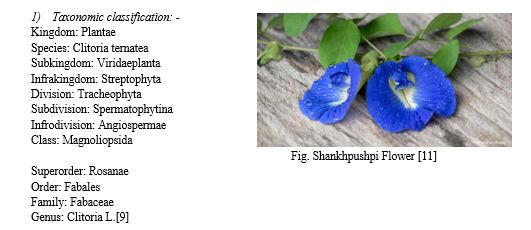
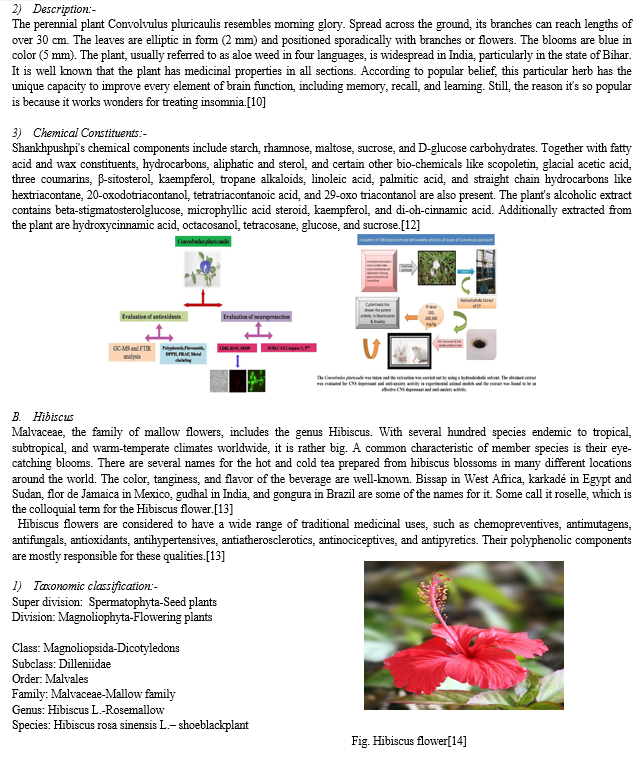

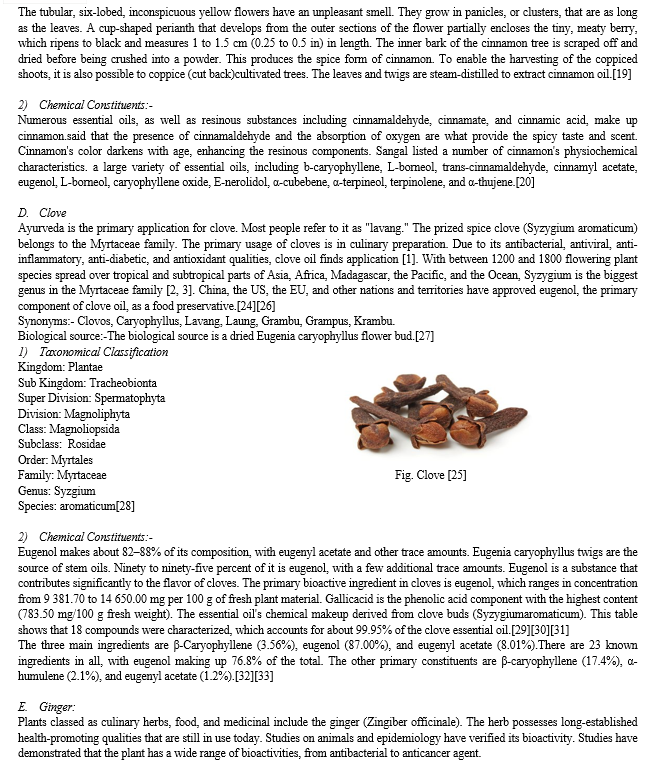
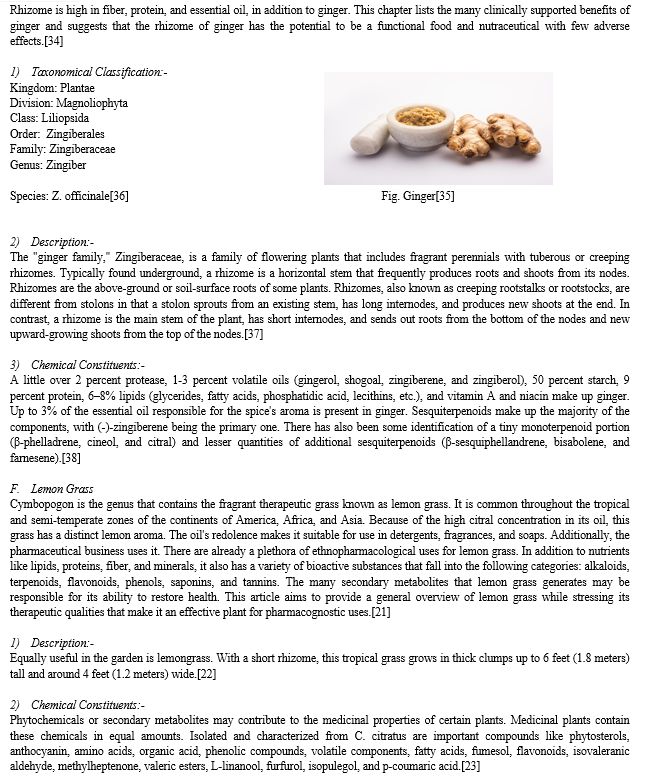
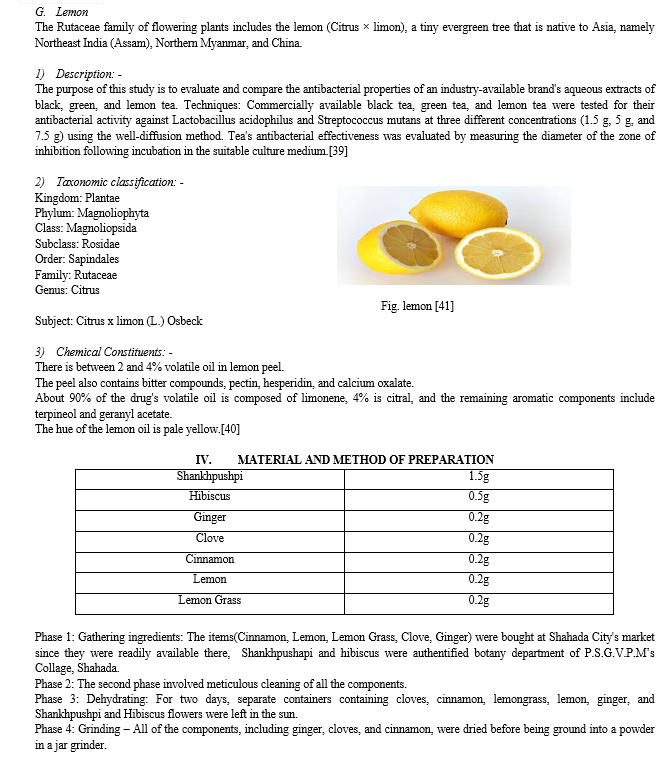
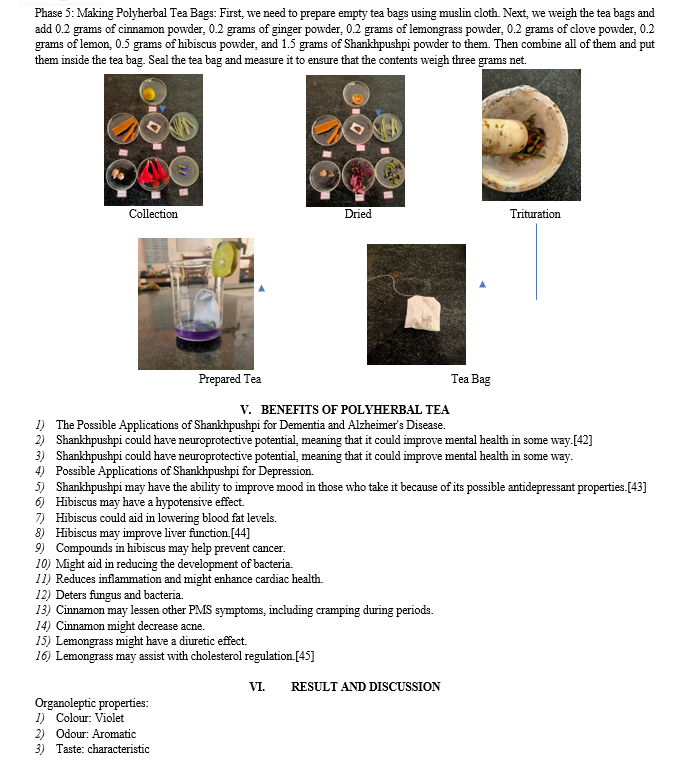
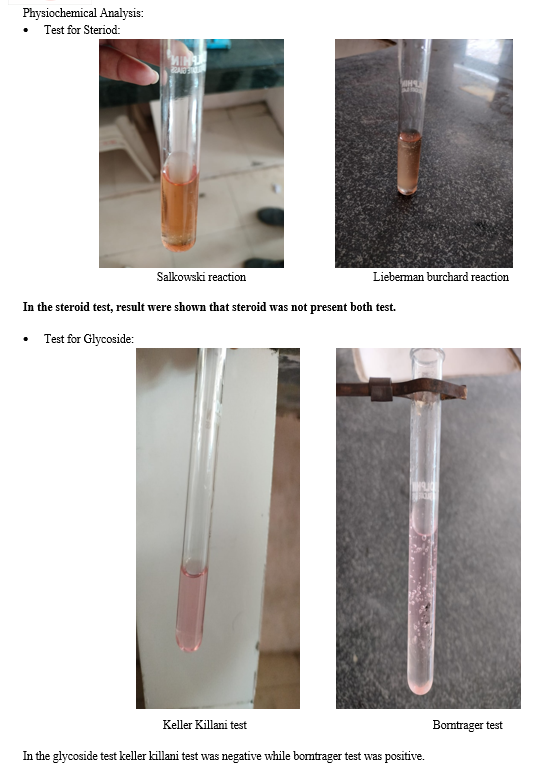
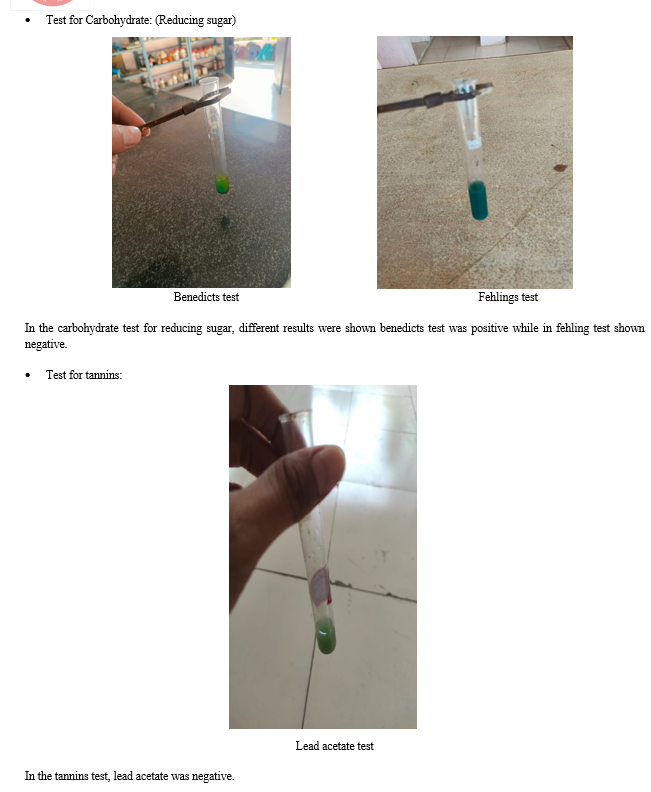
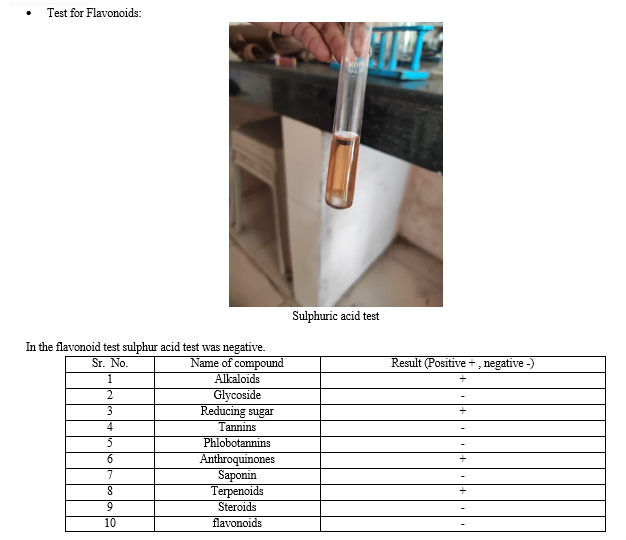
VII. ACKNOWLEDGEMENT
We would like to express our genuine thanks to Dr. Sunila Patil , Assistant Professor P.S.G.V.P.M’s college of Pharmacy, Shahada, Maharashtra, India for guiding us. We would also like to thank all of those who are involved directly or indirectly for completing this research paper.
Conclusion
In summary, the prepared polyherbal herbal tea exhibits antioxidant activity and a phytonutrient content. The resulting herbal tea formulation has potential applications in medicine, including antibacterial and anti-inflammatory effects. Benefits of polyherbal tea include lowering blood pressure, enhancing liver function, lowering blood fat, reducing the growth of bacteria and fungus, preventing cancer, enhancing heart health, reducing acne, and regulating cholesterol. These polyherbal teas strengthen the immune system, increase energy, and benefit the brain.
References
[1] Brunton, P.A.; Hussain, A. The erosive effect of herbal tea on dental enamel. J. Dent. 2001,29, 517–520. [2] Vuong, Q.V. Epidemiological Evidence Linking Tea Consumption to Human Health: A Review. Crit. Rev. Food Sci.2014,54,523–536. [3] Zhao, J.; Deng, J.W.; Chen, Y.W.; Li, S.P. Advanced phytochemical analysis of herbal tea in China. J. Chromatogr. A2013,1313,2–23. [4] Augspole, I.; Duma, M.; Ozola, B. Bioactive compounds in herbal infusions. Agronomy Res. 2018,16, 1322–1330 [5] Lis, B.; Olas, B. Pro-health activity of dandelion (Taraxacum of?cinale L.) and its food products—History and present. J. Funct.Foods 2019,59, 40–48. [6] Sang, S.; Snook, H.D.; Tareq, F.S.; Fasina, Y. Precision Research on Ginger: The Type of Ginger Matters. J. Agric. Food Chem.2020,68, 8517–8523. [CrossRef] [PubMed] [7] Van Wyk, B.E.; Gorelik, B. The history and ethnobotany of Cape herbal teas. S. Afr. J. Bot. 2017,110, 18–38. [8] Berry, M. (2002, September). HERBAL MEDICINES: A GUIDE FOR HEALTHCARE PROFESSIONALS (2nd EDITION). Complementary Therapies in Medicine, 10(3), 186–187. https://doi.org/10.1016/s0965229902000778 [9] Deshpande SM, Srivastava DN. Chemical studies of ConvulvuluspluricaulisChoisy. J Indian Chem Soc. 1969; 46(8): 759-760. [10] Sethiya NJ, Mishra\\\'s. Australian J Med Herbalism 2010; Vol. 22 (1): 19-25. [11] https://images.app.goo.gl/Pw3QUhbQHa9bfrCBA [12] Dandekar U, Chandra R, Dalvi S, Joshi M, Gokhde P, Sharma A et al. J Ethnopharmacol 1992; Vol. 35 (3): 285-288. [13] Gomare KS, Mishra DN. FTIR spectroscopic analysis of phytochemical Extracts from Hibiscus rosa–sinensis L. used for hair disorder. International Journal of Recent Trends in Science and Technology. 2018;70–75. [14] https://images.app.goo.gl/on22fzdzxgKxf8pS6 [15] Ragunathan, V., Sulochana, N., A new flavonol bioside from the flowers of Hibiscus vitifolius Linn. And its [16] Hypoglycemic activity. Journal of Indian Chemical Society 1994; 71: 705–706 [17] Subasinghe, S., Hettiarachchi, C.S. and Iddagoda, N. 2016. In-vitro propagation of cinnamon (Cinnamomum verum Presl) using embryos and in vitro axillary bud. Journal of Advance Agricultural Technologies, 3(3):164-169. [18] https://images.app.goo.gl/7yg1j9nTQpqtCWRv8 [19] Senanayake UM, Lee TH, Wills RBH. Volatile constituents of cinnamon (Cinnamomum zeylanicum) oils. Journal of Agricultural and Food Chemistry. 1978;26(4):822–824. [20] Singh G, Maurya S, deLampasona MP, Catalan CAN. A comparison of chemical, antioxidant and antimicrobial studies of cinnamon leaf and bark volatile oils, oleoresins and their constituents. Food and Chemical Toxicology. 2007;45(9):1650–1661. [21] S.M. Rahim, E.M. Taha, Z.M. Mubark, S.S. Aziz, K.D. Simon, A.G. Mazlan [22] Cymbopogon citratus on hydrogen peroxide-induced oxidative stress in the reproductive system of male rats system Biol. Reproduct. Med., 59 (2013), p. 329 [23] J.T. Paula, L.C. Paviani, M. Foglio, I.M. Sousa, G.H. Duarte, M. Jorge, M. Eberlin, F. Cabral Extraction of anthocyanins and luteolin from Arrabida eachica by sequential extraction infixed bed using supercritical CO2, ethanol and water as solvents J. Supercrit. Fluids, 86 (2014), pp. 100-107 [24] Milind P. and Deepa k. : Clove: A Champion Spice, Int J. of Res Ayu & Pharm, 2011, 2(1) 47-54. [25] https://images.app.goo.gl/2bToxdnviiAYiDn78 [26] Hussain S. , Rahman R. , Mushtaq A. ,[….] : Clove: A Review of a precious with multiple uses: Int J. of Che & Bio Sci, 2017. [27] Cock I. E. , Cheesman M. (2018), Plant of the genus syzygium (Myrtaceae): A review on ethnobotany, medicinal properties & Phytochemistry. Bioactive comps. Of Med. Plant. Ed Goyal MR, Ayeleso A Apple Academic Press, USA. [28] Hu Q. , Zhou M. , & Wei S. : Progess on the Antimicrobical activity research of clove oil and eugenol in the food antisepsis field :J. Of Food sci, Vol 83, Iss 6, 2018. [29] Dua Anita, Singh Avtar, Mahajan Ritu: Antioxidants of clove (syzygium aromaticum) prevent metal induced oxidative damage of biomolecules: Int. Res j. Pharm. 2015, 6 (4). [30] Alfikri F. N., Pujiarti R., [...]: Yield, Quality, and Antioxidant activity of clove (Syzygium aromaticum L. Bud oil at the Different Phenological Stages in Young and Mature Trees(2020). [31] Dr. Verma S. K., Dr. Garg A. K., [...]: World J of Pharma Res.: Vol. 7 (5) 2018. [32] Md. Uddin A., Md. Shahinuzzaman, Md. Rana S., & Yaakob Z.: Study of chemical composition and medicinal Properties of volatile oil from clove buds: IJPSR, 2017; Vol.8(2). [33] MS. RD. Link R., 8 Surprising health benefits of cloves: Nutrition. [34] Afshari, A. T., et al. 2007. The effect of ginger on diabetic nephropathy, plasma antioxidant capacity and lipid peroxidation in rats. Food Chemistry 101(1): 148-153. Retrieved April 8, 2008. [35] https://images.app.goo.gl/8q6FxY9d6fxKvmx17 [36] Al-Achi, A. n.d. A current look at ginger use. US Pharmacist. Retrieved April 8, 2008. [37] Al-Amin, Z. M. et al. 2006. Anti-diabetic and hypolipidaemic properties of ginger (Zingiber officinale) in streptozotocin-induced diabetic rats. British Journal of Nutrition 96: 660-666. Retrieved April 8, 2008. [38] Chen, J.-C., L.-J. Huang, S.-L. Wu, S.-C. Kuo, T.-Y. Ho, and C.-Y. Hsiang. 2007. Ginger and its bioactive component inhibit enterotoxigenic Escherichia coli heat-labile enterotoxin-induced diarrhea in mice. Journal of Agricultural and Food Chemistry 55(21): 8390–8397. Retrieved April 8, 2008. [39] Wright, A. Clifford. History of Lemonade, CliffordAWright.com [40] The origins Archived 2011-10-19 at the Wayback Machine, limmi.it. [41] https://images.app.goo.gl/CLatzm6JVPs3c2Dp8 [42] Chetna AHW.Causes & Cure Of Stress (Migraine & Headache).Diamond Pocket Books (P) Ltd.1997. [43] Balkrishna A.Secrets of Indian herbs. Divya Prakashan.2008. [44] Hindu V.Shankhpushpi: A short review.IRJP.2012;3(1):81-83. [45] Beverages, tea, hibiscus, brewed [Internet]. FoodData Central. [cited 2022Nov28].
Copyright
Copyright © 2024 Miss. Deveshvari Deepak Chaudhary , Mr. Tanmay Rajendra Chaudhari , Mr. Rutik Gopal Chaudhari , Mr. Sunil Kanaram Chaudhari , Dr. Sunila Patil . This is an open access article distributed under the Creative Commons Attribution License, which permits unrestricted use, distribution, and reproduction in any medium, provided the original work is properly cited.

Download Paper
Paper Id : IJRASET61356
Publish Date : 2024-04-30
ISSN : 2321-9653
Publisher Name : IJRASET
DOI Link : Click Here
 Submit Paper Online
Submit Paper Online

